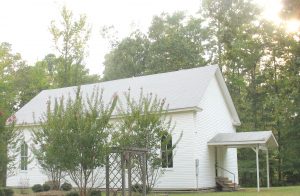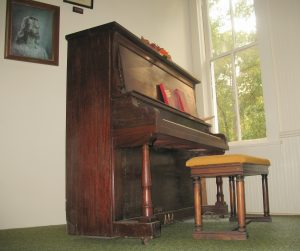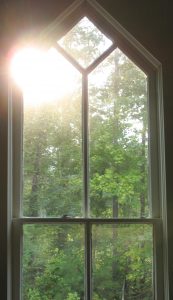
Every year, on the 2nd Sunday in August, my grandmother’s church would have their annual Homecoming. Somewhere along the way, someone realized that August in Arkansas was pretty hot and humid to be having a service followed by dinner on the grounds. The Mt. Carmel United Methodist Church of Jacinto then moved their Homecoming to the 2nd Sunday in September.
In my earlier years, we would arrive with the sun a quarter of the way across the sky, if we could see it through the leafy green oak trees towering above us. With my dad driving, of course, we’d turn off the road into the churchyard, gravel crunching beneath the tires. The hymns being played on the old upright piano could be heard coming through the front doors of the church, beckoning those still standing on the grounds to come in and find a seat in one of the old, wooden pews. At the sound of the steps creaking under your feet, heads would turn to see who was coming in late and then give a friendly nod to acknowledge that they were glad to see you made it. Homecoming meant signing your name in the register as you entered, so you would be sure to get a reminder in the mail some 11 months later that it was once again time for Homecoming and everyone hoped to see you again. After picking up a bulletin with the order of the service, you could usually find enough seats in a couple of rows of pews for everyone in your family to sit, if not all together, at least in close enough proximity to one another.
My grandmother, long-time member and lifelong Methodist, Louise Ione Gray Parham Mann, would be seated at the piano most years. She was no classically trained pianist, but she could pound out “The Church in the Wildwood” with the best of them. She would turn from her seat on the piano bench and smile to let you know she, too, saw you coming in late, but she was glad to see you made it, especially if you were one of her children or grandchildren.

During the hymn-singing portion of the service, you could call out the number of any hymn you wanted to sing and Grandma would comply after the song leader repeated the hymn number, and then again for the harder-of-hearing. If it was a song everyone liked, you’d hear whispers of, “Oh, that’s a good one!” and the enthusiastic page turning to get to that hymn before everyone started singing. “The Old Rugged Cross,” “In the Garden,” and “In the Sweet By-and-By” were popular choices, and the congregation would sing along mightily. A less popular song and you would hear murmurs of, “I don’t know this one,” and hesitant, sour notes from the voices that did sing until, mercifully, the hymn would end and everyone would breathe a sigh of relief.
Within these services was one of my favorite recitations to hear as a Baptist, who never heard it any other time, and that was the Apostles’ Creed. The words were printed in the bulletin, and I would speak the words along with the congregation: “I believe in God the Father Almighty, Maker of Heaven and Earth, and in Jesus Christ, His only Son, our Lord…” When I got to the words, “I believe in the Holy Spirit,” I would pause. If I completed the phrase and said, “the holy catholic church,” as a Baptist, would I get in trouble? I was already pushing the envelope being in a Methodist church, seeing as how Granddaddy Smith was a Baptist preacher who persuaded my grandmother Essie Jane Jones Smith and her family to change their Methodist ways and join the Baptist church years and years before. Of course, it didn’t help that my mother had up and married a Methodist who never converted, even though they raised us five children in the Baptist church. It certainly gave me a lot to ponder over every year when this dilemma arose. It wasn’t until years later, when I began attending Methodist churches on a regular basis that I saw the words printed in the hymnal with the asterisk beside the word “catholic,” with the explanation that the word, using a lower case “c,” was the Latin form of the word “universal.” Mystery solved.
The offering plate would be passed around, and I might be given a dime or quarter to put in as it went by me. I could see bills crumpled and folded, and the occasional check, turned upside down of course because it wasn’t proper to show off how much money you were giving, with lots of silver coins sifting their way to the bottom of the plate. Then it was time for the sermon.
I wish I could say I could remember at least a little snippet of any of them. After all, this was where I made the decision that when I grew up, I was going to be a Methodist. No fire and brimstone sermons from these preachers. No, their messages were mostly brief, mostly kind, and they were usually finished by 11:30 so we could get started on lunch! Sadly, I can’t recall even a little bit of them. I spent that time doodling on my bulletin or staring out one of the diamond-point windows that have been the hallmark of this church, listening to the buzz of flies when the windows were up or the hum of the air conditioner when one finally was installed. With a little sigh of relief, I would gladly rise to my feet to sing the closing hymn, which was followed by the benediction that also blessed the food we were about to eat.

Since I had to wear a dress for the service, I brought clothes for afterwards; either I would have to barricade myself in one of the two tiny Sunday school rooms in the back of the church to change, and risk someone seeing me from one of the windows, or go behind the gas tank in the backyard of the church and squat clumsily to change while not being seen. It was certainly a lesson in dressing quickly, if not awkwardly. Then I would emerge, much cooler for the change, and ready to eat. Being young had its advantages. Since there were so many women putting the food out and getting things ready, I wasn’t expected to do much other than help get our food and picnic items from a box in the car.
Long tables with chipping white paint settled under the canopy of the trees, groaning under the weight of so many casserole dishes, plates of fried chicken, potato salad, homemade sour pickles, bowls of butterbeans, pies, cakes, everything you would expect to find at a church potluck. There was so much food; it was hard to decide what all to eat – so I usually got too much, and then would hear, “Your eyes got too big for your stomach,” when I still had a half a plate left to eat after getting full.
There was an addition of an honest-to-goodness outhouse a little ways into the woods so that you didn’t have to find a spot behind a tree (not that I ever did! I would wait until we got to Grandma’s house rather than risk getting covered in ticks and chiggers). A bathroom with running water eventually was built close to the church, which has made it easier for everyone to stay longer. A pavilion, built from the trees that once shaded the old tables holding the food, was designed by my brother and built with the work of men who had ties to the community. A memorial garden, the Eagle Scout project of one of my nephews, sits next to the church and offers a little spot to sit and reflect in the shade of the crape myrtles.
Many Homecomings have gone by over the years. The old Mt. Carmel Methodist Church is no longer an organized church, but a building on the historic register. It’s still as beautiful as it ever was, sitting quietly in the back of the churchyard, white paint a little chippy but nonetheless comforting in its familiarity. Stepping into it, you can see the pews, the green carpet, the portrait of Jesus on the back wall and remember all the faces from over the years who once turned to greet you with a smile. Every year the crowd appears; slightly different and slightly smaller due to the passing away of those with the familiar faces, and their families from farther away not coming anymore. It’s true that you can’t go home again, but you can go to Homecoming every second Sunday in September, and feel like you’ve come back to where you belong.
